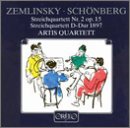| All Artists: Zemlinsky, Schoenberg, Artis Quartet Title: String Quartets Members Wishing: 0 Total Copies: 0 Label: Orfeo Release Date: 4/20/1994 Genre: Classical Styles: Chamber Music, Historical Periods, Classical (c.1770-1830) Number of Discs: 1 SwapaCD Credits: 1 UPC: 750582331428 |
Search - Zemlinsky, Schoenberg, Artis Quartet :: String Quartets
 | Zemlinsky, Schoenberg, Artis Quartet String Quartets Genre: Classical
|
Larger Image |
CD Details |
CD ReviewsA Mélange of Confluences... Sébastien Melmoth | Hôtel d'Alsace, PARIS | 02/24/2009 (5 out of 5 stars) ".
Zemlinsky was just three years older than Schönberg; but there is a vast difference between the trajectory of their arts and careers--which, though Zemlinsky was a very competent craftsman and talented artist, must ultimately be attributed to the rare phenomenon of Schönberg's genius. Their history at turn-of-the-century Vienna is well known. At the age of sixteen Zemlinsky entered the Vienna Conservatory where his instructors included Anton Door and the brothers Fuchs--Robert and Johann Nepomuk. In 1893 Zemlinsky was admitted to the Vienna Society of Musicians [Tonkünstlerverein], and by 1896 he was on good terms with Brahms who bestowed assistance and encouragement towards Zemlinsky's Jugendstil style of which the Op. 3 Clarinet Trio and Op. 4 String Quartet are prime examples. Zemlinsky met Schönberg in late-1895, and proceeded to share with him the pearls of his Conservatory training. At some point the two apparently audited some of Bruckner's lectures at the University of Vienna. And of course they followed Mahler's activities as artistic director of the Vienna Court Opera from 1897. Under Zemlinsky's tutelage Schönberg wrote some early string quartets--only bits of which survive. The ultimate fruition of their collaboration, however, is Schönberg's D-major String Quartet of 1897. Zemlinsky had shown parts of this work to Brahms in late-winter 1896, and the perishing gruff Old Papa was enthusiastic about what he saw. Zemlinsky then arranged for the Quartet to be performed at a private concert of the Tonkünstlerverein on 17 Mar. 1898, followed by a public première on 20 Dec. 1898--which indeed received praise from the catty Hanslick. Though it was not published during his lifetime, Schönberg carefully preserved his D-major Quartet amongst his papers in a similar fashion as Bruckner had done with the d-minor Symphony he dubbed "No. 0". Likewise, Schönberg's 1897 Quartet should be considered as "No. 0" so as to designate its place in the canon of his five string quartets. The Quartet is a splendid piece of Jugendstil which exemplifies Schönberg's First Period ethos. Its Brahmsian/Dvorákian antecedents notwithstanding, the work is nevertheless fresh and original. (Note the use of sharp accelerandos which are also characteristic of the 1894 Klavierstücke [c#-minor Andantino; F-major Andantino grazioso; a-minor Presto].) Most interesting is its presentiment of Schönberg's penchant for the grotesque and arabesque in the quasi-Schubertian Intermezzo-Andantino grazioso (f#-minor) wherein Schönberg employs the peculiar glassy harmonics of sul ponticello achieved am steg (by bowing on the bridge). Schönberg, WoO String Quartet No. 0 (D-major): Artis Quartett Wien: I. Allegro molto [05'31"] II. Intermezzo [03'40"] III. Theme and (v) Variations [07'27"] IV. Allegro [04'17"]. Leipziger Streichquartett: I. Allegro molto [09'06"] II. Intermezzo [04'08"] III. Theme and (v) Variations [08'32"] IV. Allegro [04'34"]. LaSalle Quartet: I. Allegro molto [06'20"] II. Intermezzo [03'42"] III. Theme and (v) Variations [06'52"] IV. Allegro [04'41"]. ~~~~~~~~~~~~~~~~~~~~~~~~~~~~~~~~~~~~~~~~ With the production of his Op. 4 String Sextet (1899), Schönberg's genius continued apace. And as time passed the rôles of the Z/S duo reversed: it was now Zemlinsky's turn to follow Schönberg (and Mahler) in the expansion of form and tonality. Withal, we have Zemlinsky's chamber music magnum opus: his Op. 15 String Quartet No. 2 in f#-minor. Dedicated to Schönberg, Zemlinsky intertextually cites some of Schönberg's melodies from the Sextet, First, and Second String Quartets. The form is in the manner of Mahler's multi-sectional motto-and-episode technique from the Fifth Symphony: ultimately this work is an individualistic refraction-amalgam which may be seen as tantamount to a conceptual Mahlerian string quartet. At the same time Zemlinsky anticipates the post-war "Neue Sachlichkeit [New Objectivity]" taken up by Hindemith, Krenek, Toch, et alii. Indeed, Zemlinsky's four string quartets deserve a place alongside those of Bartók, Hindemith, Schönberg, Reger, and Toch. . Zemlinsky, Op. 15 String Quartet No. 2 (f#-minor): Artis Quartett Wien: I. Sehr mäßig-Moderato-Andante mosso-Allegretto [09'08"] II. Adagio [07'13"] III. Schnell-Andante [08'42"] IV. Allegro molto-Langsam-Andante [11'10"]. LaSalle Quartet: I. Sehr mäßig-Moderato-Andante mosso-Allegretto [09'44"] II. Adagio [08'15"] III. Schnell-Andante [09'15"] IV. Allegro molto-Langsam-Andante [11'43"]. ." |

 Track Listings (5) - Disc #1
Track Listings (5) - Disc #1